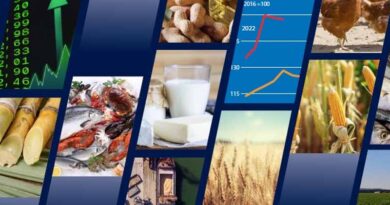China: During the New Year’s Day and Spring Festival, the vegetable market showed a booming situation in both supply and sales, and residents’ “vegetable baskets” were fully stocked and prices were stable
06 January 2024, China: Come and pay attention to the “vegetable basket” prices. The latest data from the Ministry of Agriculture and Rural Affairs shows that the national vegetable basket index was 123.32 in December 2023, an increase of 6.89 points from the previous month, and vegetable prices showed seasonal increases.
In December 2023, the national average wholesale price of 28 types of vegetables monitored by the Ministry of Agriculture and Rural Affairs was 4.95 yuan per kilogram, an increase of 8.1% month-on-month and a year-on-year increase of 5.5%. Among them, the prices of 24 types of vegetables increased month-on-month and 4 types fell. The items with a month-on-month increase of more than 30% include leeks, eggplants, green peppers, etc.
Associate researcher, Institute of Agricultural Information, Chinese Academy of Agricultural Sciences, the main reason for the seasonal increase is: First, since mid-December (2023), the weather situation has been relatively complicated, with a concentration of unfavorable weather such as cold waves, freezing, rain and snow, resulting in out-of-field vegetable harvesting. Second, after vegetable production and sales entered the winter mode, facility vegetables and “South-North Vegetable Transportation” became the main supply method in the market, and the increase in costs drove up vegetable prices.
Experts said that during the New Year’s Day and Spring Festival, due to the strong demand for stocking in the market, the vegetable market showed a booming situation in both supply and sales. It is expected that vegetable prices will continue to rise seasonally in the later period.
Zhang Jing, associate researcher at the Institute of Agricultural Information of the Chinese Academy of Agricultural Sciences: From the perspective of later supply, the area of vegetable fields across the country increased by 1.3% year-on-year. The “South-North Vegetable Transport” vegetable market is sufficient. After the cold wave weather, northern facility vegetable production has also gradually resumed. . In the later period, the temperature in most areas across the country will be slightly higher than the same period in previous years, which is generally conducive to vegetable production. It is expected that vegetable prices will not increase too much in the later period.
Beijing: The supply of vegetables from many producing areas increases
Around New Year’s Day, the pace of “vegetable transportation from the south to the north” accelerated, and vegetable production in facilities in the north gradually resumed. This caused some changes in vegetable supply and prices in Beijing. Let’s take a look at the reporter’s visit to Xinfadi, the largest agricultural product wholesale market in Beijing.
Merchants at Beijing’s Xinfadi Agricultural Products Wholesale Market told reporters that during the New Year’s Day, southern vegetables from Yunnan, Sichuan, Fujian, and Zhejiang were successively put on the market in batches. Yunnan beans alone accounted for about 80% of the total supply of beans and vegetables in Xinfadi Market. In addition, the supply of hot peppers from Fujian and Guangdong, Chinese cabbage and white radish from Hubei has also increased significantly, while the prices of winter storage vegetables such as onions, potatoes and carrots have remained stable due to their large storage volumes.
Affected by the strong cold wave weather in the early period, the output of facility vegetables in the north dropped, and the prices of tomatoes, etc. rebounded sharply.
The person in charge of Xinfadi Market said that recently, the production capacity of vegetables in northern facilities is recovering, and the supply situation will gradually improve in the later period, and the prices of some vegetables will also stabilize. Data show that on January 2, the weighted average price of vegetables in Beijing’s Xinfadi Market was 3.31 yuan per kilogram, the same as last week.
The person in charge of Beijing Xinfadi Market said that from January to the Spring Festival, the supply of vegetables in the Beijing market will mainly rely on shelf-stable vegetables, northern greenhouse vegetables and southern vegetables. The (daily) market volume will remain above 20,000 tons, and prices will basically remain stable. As the Spring Festival approaches, prices will rise seasonally due to consumption.
Chongqing Qianjiang: Morels harvest ahead of schedule
In the past few days, the first batch of morels in Qianjiang District, Chongqing has ushered in its first “harvest season”, and they are on the market 20 days earlier than in previous years.
The reporter saw at the morel planting base in Shihui Town, Qianjiang District, that in the planting greenhouse, clusters of morels sprouted from the ground and held up brown “little umbrellas”. Looking around, on the dozens of meters long mushroom bed, plump and plump morels are densely packed and growing gratifyingly. The villagers carried buckets and knives at the same time, shuttled through the greenhouses, and skillfully picked the first batch of morels.
It is understood that the temperature in Qianjiang District is slightly higher this year, and the first batch of morels has entered the peak production period. A large number of fresh mushrooms are put on the market every day in the planting base.
Secretary General of the Chongqing Qianjiang District Morel Industry Technology Association (this year) launched the product 20 days ahead of schedule. This year, we have planted about 5,000 acres of morels in the entire district, and the output value per mu can reach 40,000 yuan.
Kaijiang, Sichuan: Hairy crabs are on the market in large quantities
During New Year’s Day, hairy crabs from Kaijiang County, Dazhou, Sichuan, are on the market in large quantities. This batch of hairy crabs is not only large in size and of good quality, but the price has also dropped a lot, making them popular in markets all over the world.
At an aquaculture base in Huilong Town, Kaijiang County, Sichuan, several workers were busy raising cages and closing nets to catch the third batch of hairy crabs in winter. Compared with the hairy crabs that were launched in mid-October last year, this batch is larger in size and full of cream, attracting a large number of nearby customers to rush to order.
Freshly marketed hairy crabs are sent to major local farmers markets and supermarkets. Because the price is much lower than before, it is deeply loved by the public.
It is understood that the hairy crab fishing season in Kaijiang County is relatively long, lasting from October to January of the following year. Up to now, the hairy crab breeding water area in Kaijiang County has reached more than 8,000 acres, with an output value of nearly 96 million yuan.
Mishan, Heilongjiang: Busy winter fishing on Qingshan Lake
On January 1, 2024, Qingshan Lake Reservoir in Mishan City, Heilongjiang Province ushered in the annual winter fishing season. The event was bustling, attracting many tourists to watch and participate.
Every year at the end of the year and the beginning of the new year, Qingshan Lake holds a grand winter fishing event. At 11 o’clock in the morning, on the ice-covered lake, as the tractor winch rotated, a large net of more than a thousand meters was slowly pulled out, and the jumping fish appeared in front of people.
Closing the net is the most spectacular and ornamental scene in the entire winter fishing activity. As soon as the big and lively fish lands, onlookers flock to buy it.
Qingshan Lake is located in Honglin Village, Taiping Township, Mishan City, Heilongjiang Province, covering an area of more than 1,200 acres. There are many kinds of fish in Qingshan Lake, including dozens of species such as white fish, carp, and catfish. It can produce more than 200,000 catties of fish every year, which are exported to Beijing, Shanghai and other places.
Also Read: Use of Nano Urea decreases Wheat yield by 20%: PAU
(For Latest Agriculture News & Updates, follow Krishak Jagat on Google News)















